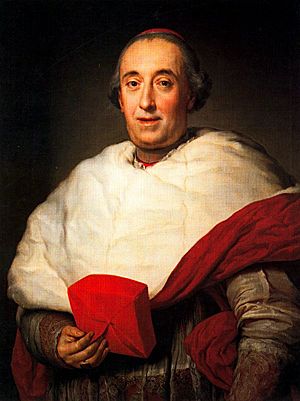Francesco Saverio de Zelada facts for kids
Quick facts for kids Francesco Saverio de Zelada |
|
|---|---|
| Archivist of the Vatican Secret Archives Librarian of the Vatican Apostolic Library |
|

Portrait - Anton Raphael Mengs (1773-74).
|
|
| Church | Roman Catholic Church |
| Appointed | 15 December 1779 |
| Reign ended | 19 December 1801 |
| Predecessor | Alessandro Albani |
| Successor | Luigi Valenti Gonzaga |
| Other posts |
|
| Orders | |
| Ordination | 23 October 1740 |
| Consecration | 28 December 1766 by Pope Clement XIII |
| Created Cardinal | 19 April 1773 |
| Rank | Cardinal-Priest |
| Personal details | |
| Birth name | Francesco Saverio de Zelada |
| Born | 27 August 1717 Rome, Papal States |
| Died | 19 December 1801 (aged 84) Rome, Papal States |
| Buried | Santi Silvestro e Martino ai Monti |
| Parents | Juan de Zelada Manuela Rodríguez |
| Previous post |
|
| Alma mater | La Sapienza |
Francesco Saverio de Zelada (born August 27, 1717, in Rome – died December 19, 1801, in Rome) was an important leader in the Roman Catholic Church. He was a cardinal from a Spanish family. He worked for the Pope's government, called the Papal Curia, and helped with international relations for the Holy See.
Contents
Early Life and Education
Francesco Saverio de Zelada was born in Rome, which was then part of the Papal States. He went to the University of La Sapienza. There, he studied both church law (canon law) and civil law. He became a priest on October 23, 1740.
Becoming a Cardinal
Zelada was named an Archbishop on December 23, 1766. This was a special title, as he was not in charge of a specific area. Later, on April 19, 1773, he became a cardinal. This was a very important position in the Catholic Church.
Pope Clement XIV chose him to lead important talks for the Holy See. He also helped write a special document called Dominus ac Redemptor. This document, issued on June 8, 1773, officially ended the Society of Jesus (the Jesuits) at that time.
Key Roles and Diplomacy
Cardinal Zelada held many important jobs. From 1783 to 1784, he was the Camerlengo of the Sacred College of Cardinals. This meant he managed the finances of the College of Cardinals.
His most important role was serving as the Cardinal Secretary of State for Pope Pius VI. He held this position from 1789 to 1796. During this time, he had to deal with the difficult situation of the French Revolution. He worked to make peace, even signing a peace agreement in 1793.
When French forces took over Rome, Cardinal Zelada moved to Tuscany for safety. After Pope Pius VI passed away, Zelada took part in the Papal conclave of 1800. This was the meeting where cardinals chose the next Pope, who became Pope Pius VII.
A Collector and Scholar
Cardinal Zelada was the Librarian of the Holy Roman Church from December 15, 1779, until his death. He was known for being a great collector. He collected many books, old coins, medals, and other art pieces. He was also interested in science.
He had a telescope set up in his home. When he became the Cardinal-Librarian, he moved the telescope to his new residence. He even built an observatory at the Collegio Romano, a famous school in Rome.
After he died, his collection of printed books went to the Vatican Library. His handwritten documents were sent to Spain for safekeeping and later went to a library in Toledo. He also gave his collection of anatomical models to the Ospedale di Santo Spirito, a hospital.
Cardinal Zelada was buried in the church of San Martino ai Monti in Rome.
See also
 In Spanish: Francisco Javier Zelada y Rodríguez para niños
In Spanish: Francisco Javier Zelada y Rodríguez para niños

